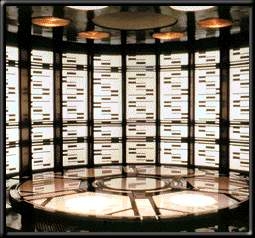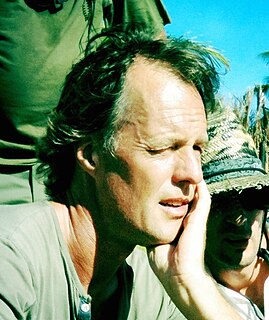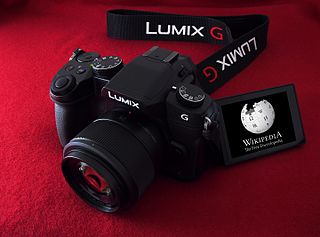
A tracking shot is any shot where the camera follows backward, forward or moves alongside the subject being recorded. In cinematography, the term refers to a shot in which the camera is mounted on a camera dolly that is then placed on rails – like a railroad track. As a result, this type of shot is often referred to as a dolly shot. A handheld steadycam or gimbal may also be used for smaller scale productions. The camera is then pushed along the track while the scene is being filmed or moved manually when using a handheld rig.

A transporter is a fictional teleportation machine used in the Star Trek science fiction franchise. Transporters allow for teleportation by converting a person or object into an energy pattern, then sending ("beaming") it to a target location or else returning it to the transporter, where it is reconverted into matter ("rematerialization"). Since its introduction in Star Trek: The Original Series in 1966, the name and similar concepts have made their way to other science fiction scenarios, in literature, games (SimEarth), etc.

Augmented reality (AR) is an interactive experience of a real-world environment where the objects that reside in the real world are enhanced by computer-generated perceptual information, sometimes across multiple sensory modalities, including visual, auditory, haptic, somatosensory and olfactory. AR can be defined as a system that incorporates three basic features: a combination of real and virtual worlds, real-time interaction, and accurate 3D registration of virtual and real objects. The overlaid sensory information can be constructive, or destructive. This experience is seamlessly interwoven with the physical world such that it is perceived as an immersive aspect of the real environment. In this way, augmented reality alters one's ongoing perception of a real-world environment, whereas virtual reality completely replaces the user's real-world environment with a simulated one. Augmented reality is related to two largely synonymous terms: mixed reality and computer-mediated reality.

Steadicam is a brand of camera stabilizer mounts for motion picture cameras invented by Garrett Brown and introduced in 1975 by Cinema Products Corporation. It mechanically isolates the camera from the operator's movement, allowing for a smooth shot, even when the operator moves over an irregular surface.

A gimbal is a pivoted support that permits rotation of an object about an axis. A set of three gimbals, one mounted on the other with orthogonal pivot axes, may be used to allow an object mounted on the innermost gimbal to remain independent of the rotation of its support. For example, on a ship, the gyroscopes, shipboard compasses, stoves, and even drink holders typically use gimbals to keep them upright with respect to the horizon despite the ship's pitching and rolling.

In cinematography, the dolly grip is a dedicated technician trained to operate the camera dolly. This technician places, levels, and moves the dolly track, then pushes and pulls the dolly and usually a camera operator and camera assistant as riders. If the dolly has a moveable vertical axis, such as a hydraulic arm, then the dolly grip also operates the "boom". If both axes are used simultaneously, this type of dolly shot is known as a compound move.
In engineering, iso-elastic refers to a system of elastic and tensile parts which are arranged in a configuration which isolates physical motion at one end in order to minimize or prevent similar motion from occurring at the other end. This type of device must be able to maintain angular direction and load-bearing over a large range of motion.
Garrett Brown is an American inventor, best known as the creator of the Steadicam. Brown's invention allows camera operators to film while walking without the normal shaking and jostles of a handheld camera. The Steadicam was first used in the Hal Ashby film Bound for Glory (1976), receiving an Academy Award, and since used on such films as Rocky, filming Rocky's running and training sequences, and Return of the Jedi, where Brown walked through a Redwood forest with the Steadicam shooting film at 1 frame per second to achieve the illusion of high speed motion during the speeder-bike chase.

Canon EOS is an autofocus single-lens reflex camera (SLR) and mirrorless camera series produced by Canon Inc. Introduced in 1987 with the Canon EOS 650, all EOS cameras used 35 mm film until October 1996 when the EOS IX was released using the new and short-lived APS film. In 2000, the D30 was announced, as the first digital SLR designed and produced entirely by Canon. Since 2005, all newly announced EOS cameras have used digital image sensors rather than film. The EOS line is still in production as Canon's current digital SLR (DSLR) range, and, with the 2012 introduction of the Canon EOS M, Canon's mirrorless interchangeable-lens camera (MILC) system. In 2018 the system was further extended with the introduction of the EOS R camera, Canon's first full frame mirrorless interchangeable lens system.
Video production is the process of producing video content for video. It is the equivalent of filmmaking, but with video recorded either as analog signals on videotape, digitally in video tape or as computer files stored on optical discs, hard drives, SSDs, magnetic tape or memory cards instead of film stock. There are three stages of video production: pre-production, production, and post-production. Pre-production involves all of the planning aspects of the video production process before filming begins. This includes scriptwriting, scheduling, logistics, and other administrative duties. Production is the phase of video production which captures the video content and involves filming the subject(s) of the video. Post-production is the action of selectively combining those video clips through video editing into a finished product that tells a story or communicates a message in either a live event setting, or after an event has occurred (post-production).
Video assist is a system used in filmmaking which allows filmmakers to view and distribute a video version of a take immediately after it is filmed.
This article contains a list of cinematic techniques that are divided into categories and briefly described.

Image stabilization (IS) is a family of techniques that reduce blurring associated with the motion of a camera or other imaging device during exposure.
Moviecam SL is a movie camera product line created by Moviecam in 1996. It is a lighter version of Moviecam Compact. It can use most of the same accessories as Moviecam Compact but allows for even easier shooting from the shoulder or with a support like Steadicam systems.

Marc Koninckx is a Belgian cinematographer, member of the A.F.C., member of the S.B.C..
Elevated photography is the process of taking aerial photos using a telescoping pole or mast, or other aerial or elevated support systems, to emulate aerial photographs, or video, taken from a commercially licensed aircraft.

A camera stabilizer, or camera–stabilizing mount, is a device designed to hold a camera in a manner that prevents or compensates for unwanted camera movement, such as "camera shake".

The Panasonic Lumix DMC-G85/G80 is a mid-level DSLR-styled Micro Four-Thirds mirrorless camera announced on September 19, 2016. It is the follow-up to the Panasonic Lumix DMC-G7. Its main improvements are a weather-sealed body, an upgraded EVF, no recording limit and the addition of 5-axis in-body image stabilization which works together with lens stabilization and a Post Focus function. Like the G7, movies can be recorded in 4K resolution at 100 mbs. The G85/G80 body weighs 90g more than its predecessor.

Zinc transporter ZIP9, also known as Zrt- and Irt-like protein 9 (ZIP9) and solute carrier family 39 member 9, is a protein that in humans is encoded by the SLC39A9 gene. This protein is the 9th member out of 14 ZIP family proteins, which is a membrane androgen receptor (mAR) coupled to G proteins, and also classified as a zinc transporter protein. ZIP family proteins transport zinc metal from the extracellular environment into cells through cell membrane.

Tomica Hyper Rescue Drive Head Kidō Kyūkyū Keisatsu is a Japanese anime television series made to promote Takara Tomy's long-running Tomica toyline of miniature toy cars. It replaced Kamiwaza Wanda and aired Saturday mornings at 7:00 am on the new hour-long Anisata block on TBS and affiliated stations. The original series aired from April 15, 2017 to December 23 of the same year, while 2018 featured a monthly 8 episode follow-up. A feature film was released a week later, tying it in with its concurrently airing successor series, Shinkansen Henkei Robo Shinkalion, with main character Hayato Hayasugi crossing over with the E5 Hayabusa.















